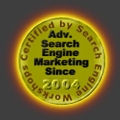 Look how old this is!
Look how old this is! I post at SearchCommander.com now, and this post was published 16 years 3 months 25 days ago. This industry changes FAST, so blindly following the advice here *may not* be a good idea! If you're at all unsure, feel free to hit me up on Twitter and ask.
I run across websites daily that not only make it difficult for visitors to contact them, but in many cases they actually seem to be discouraging their customers from reaching out via phone or email.
Perhaps they’re just too busy, or they hate answering phones, or they really have no time to deal with these interruptions.
Whatever your reason, if you’d like to avoid interaction with your Web visitors as much as possible, I’ve put together this web designers checklist of the Top 10 ways you can avoid visitor engagement, with a bonus tip at the end for no extra charge.
#1 – No Phone Number in Header
If you don’t want to encourage phone calls, then don’t put your phone number in the header of your website, and you especially don’t want to use a highly visible contrasting font or piece of art. Doing this will force customers dig deeper to reach you, eliminating many of your intrusions right off the bat.
#2 – No Contact Primary Menu Item
If you have a “contact” tab or link on your primary navigation, you could ve perceived as “encouraging” contacts, giving the misimpression that you astuall want people to contact you. Instead, put a far smaller and less visible link somewhere. Burying the link in an accordion style “About Us” submenu item is extremely effective.
#3 – No invitational text to contact you
As you write text for your website, don’t use phrases with actual calls to action such as “drop us a line” or “send us an e-mail” and especially not “call us right now”.
Using words like that will just encourage people to engage you in conversations about your product or service, especially if you were make them more visible through use of different sized font or color.
#4 – No “Contact” call to action
Some websites will utilize an actual “call to action” graphic, or even an actual contact form, which is visible on every page of the website. This ensures that no matter what page anyone lands on, instant contact to you is just a single click away. Avoid this high visibility method of engaging your visitors at all costs if customer avoidance is your goal.
#5 – No phone on contact page
You can avoid phone calls almost altogether by simply not putting your phone number on your contact page and just using a form instead.
That will make it clear that your company does not want phone calls of any kind, and most consumers will not likely dig deeper, unless they’re really mad.
A bonus strategy here is to not include a physical address either, which cuts down on your snail mail and angry walk-in surprises.
#6 – No email address on contact page
if all you have is your message and a form, with no e-mail address showing that you can tightly manage all of your contacts and do with them as you wish, and at your leisure.
If you’ve got a form in place, then be sure that you are not gathering contact information electronically into a database.
Collecting the information of your web visitors who fill out forms would only lead to the burden of having to utilize your mailing list, which could spiral into an ugly scenario building customer loyalty and communication.
#7 – No Contact Link in Footer
if you do remove the contact information from the primary navigation, then it’s considered courteous to put one in the footer of your site. That’s always the first place I look when I see a company that isn’t exactly “reaching out” to me on their website.
If you want discouracge users so they will just go away instead of digging deeper, this is a good place to do it. Make sure you do not include a contact link in your footer.
#8 – No contact link on site map
I’m talking about the visitor navigation site map, usually something like sitemap.html. This page is usually designed for ease of navigation for the user, and to some degree it also helps for the search spiders.
When I run across a company that has no visible phone number in their header, no primary contact page, and no contact link in the footer, I go to the static site map that is usually found in the footer.
When I see no link to contact information there either, I generally give up, unless I’m really determined.
#9 – No use of the word “contact” in text on site
if you were to use graphics for the words “contact us” and be sure not to even put ALT tags on it, then you could remove the risk of a search engine being able to find your contact page.
Also be sure you don’t use “contact” in your title tag, description tag, or meta keyword tags. You could even use a single image for the entire page so there would be no phone number, and no physical or e-mail address that might be findable by a search engine.
This will make the entire page practically invisible, and is far cheaper than going to a Flash designed contact page.
#10 – No “Contact” page at all
I’m seeing this more and more, and occasionally it’s due to the web designer that decided to bury the address and phone number at the bottom of an “About Us” page.
Sometimes though, it might be a webtrepreneur that just can’t get a good ROI with a contact page who actually do want to avoid communication. Leaving it out completely is a pretty sure way to never be bothered by those pesky site visitors.
Bonus Tip – Register your domain name anonymously
If you really are trying to hide, then by all means, don’t be an idiot; spring for the extra few dollars to register your domain name anonymously.
I can’t tell you the number of times I’ve had to go to a WhoIs look up to see who someone might be that owns a domain I’m investigating. Just as often as not, that person is either too stupid or too cheap to register anonymously, and I’m able to determine how to reach them via phone or e-mail.
Print out this list of tips and use it as you look at your own website.
Are you really doing everything you can to hide from your customers?
Can you use some of these strategies to make your life easier?
If this has helped, please leave me a comment here with all the extra time I’ve saved you by not having to answer phone calls and e-mails. 😉




















Very funny approach to an important topic! Nice post. I have often wondered how I can get clients to leave me alone. Now I know: do a worse job on my websites! 😉
Scott, thanks man! I provide a convenient buy now button and now I want have to worry with the customer after I have their money! a dream come true 🙂
umm. actually Scott, it’s even better to put information and make sure it is a run around. Disconnected phone numbers (or foreign language destinations), addresses that are valid by USPS standards but not yet built (gotta love those), contact forms that deny and clear the form for the slightest reasons (you must have a middle initial – try again!)
if you think no contact info is frustrating, wait till you deal withthe obfuscators! (I include Google in that camp some times)
Thanks Brian and Jason, and you too, John. You’re right, there are way to make it even harder 😉
You know what, I beleive that MSN and live.com have read your article! Congratulations, you have corporate reach! They have totally embraced your tactics on avoiding any type of real contact method for anything!
While reading the tips, I was thinking ‘is this a joke?’ Why would anyone owning a business that sells want to avoid his or her customers? But when I think about the prank calls that I received since I launched my websites, I guess you have great tips here. Thanks! 🙂
Very clever.
But here are two reasons why you might NOT want to have your phone number in neon in your header.
I understand this is a shaky argrument, but it works for my practice and type of services.
In some endeavors you do not want to talk to every Dick and Jane that might have an urge to kill some time and pick your brain. I do not mind at all putting a simple additional step in the process, like an obvious Contact button in the main navigation.
And this leads to maybe the primary reason you might want to think twice about a phone number splashed across every page in some circumstances.
Tracking.
Having your contact info on a distinct page is a nice initial sort when trying to identify what traffic is likely to have the greatest value.
Don’t get me wrong, having a phone number conspicuoaly displayed on all pages is a proven tactic in most situations.
But like so many things in search and internet marketing one size does not fit all.
-Tom Hale
LOL! Great post Scott! 😉
I love the sarcastic tone. In reality, you have two lists here, but I think your approach was more effective.
Good post! Having your contact information visible on your site is a must to build trust.Depending on the business you have, sometimes a simple contact form on your site can work.
It was Friday afternoon a few weeks ago, and, as usual I was on the golf course with the usual group.
“R-i-n-n-n-g” goes the cell phone.
The dilemma… to not answer would be to possibly miss an “opportunity”. To answer would be to break two unwritten rules: no cell calls on the course, and don’t ever answer your phone on Friday afterooon.
I answered it.
As often happens in situations when you can barely hear the caller, her accent was a bit hard to understand, and she wanted to know some details about one of our products.
I did my best to answer her questions, using the usual “Sorry I’m not in front of my computer right at the moment” line.
Then I noticed my buddies were waiting for my up by the green, and the next group was bearing down from behind.
“Ahhh… just a second… excuse me for just a minute…”
I don’t know if she heard the “whack” as I hit the ball, but when I picked the phone up off the ground she was still there.
“OK… sorry for the interruption… Why don’t you just email me with your questions and I’ll get back to you right away.”
Turns out she bought one of my most expensive programs and has become a good customer.
So there you go… Never answer your phone on the golf course on a Friday afternoon unless it’s someone who is going to turn into a good customer.
Great tips ! some people are getting frustrated when they get calls from…Hope this sounds good to avoid them in a better way.
Great Tips, some sites forget to add the most basic concepts 🙂
I’d encourage my competitors to use as many of these techniques as they can! Thanks for a good laugh.